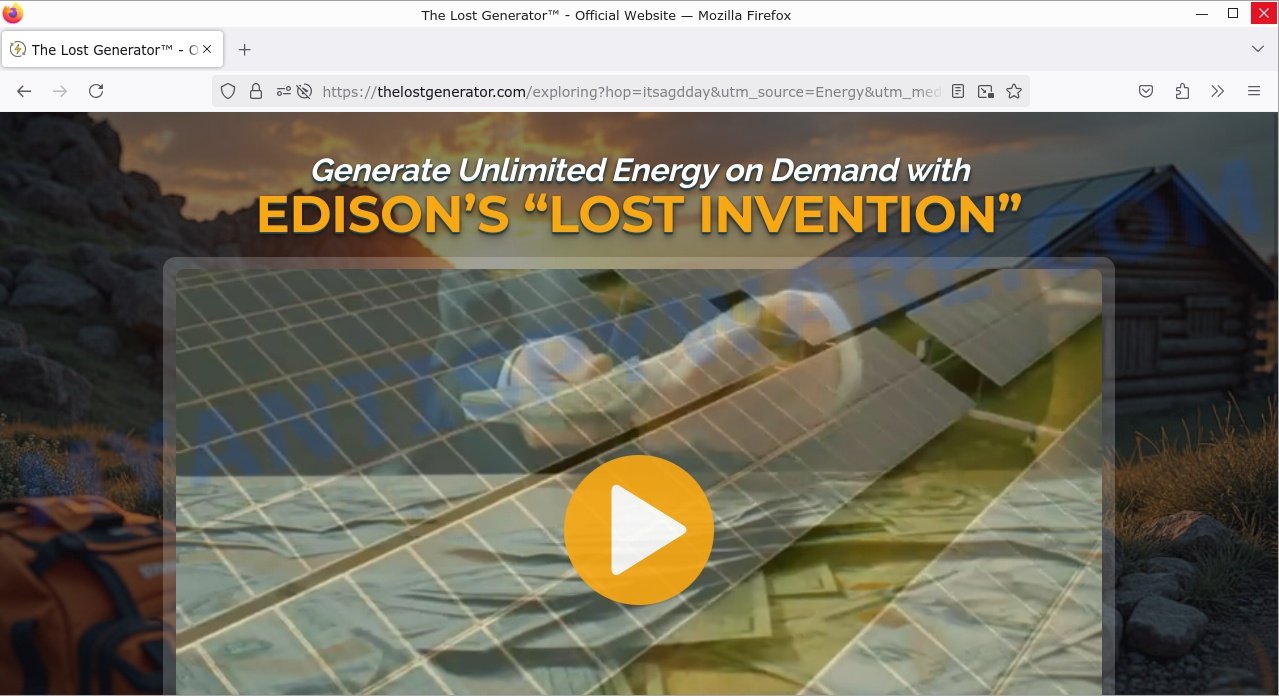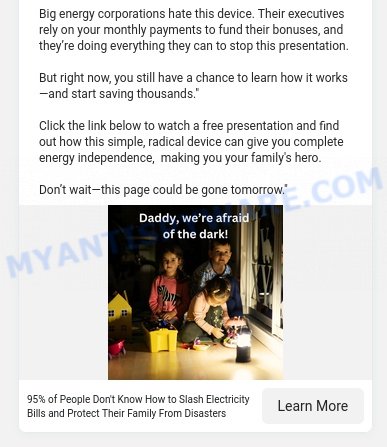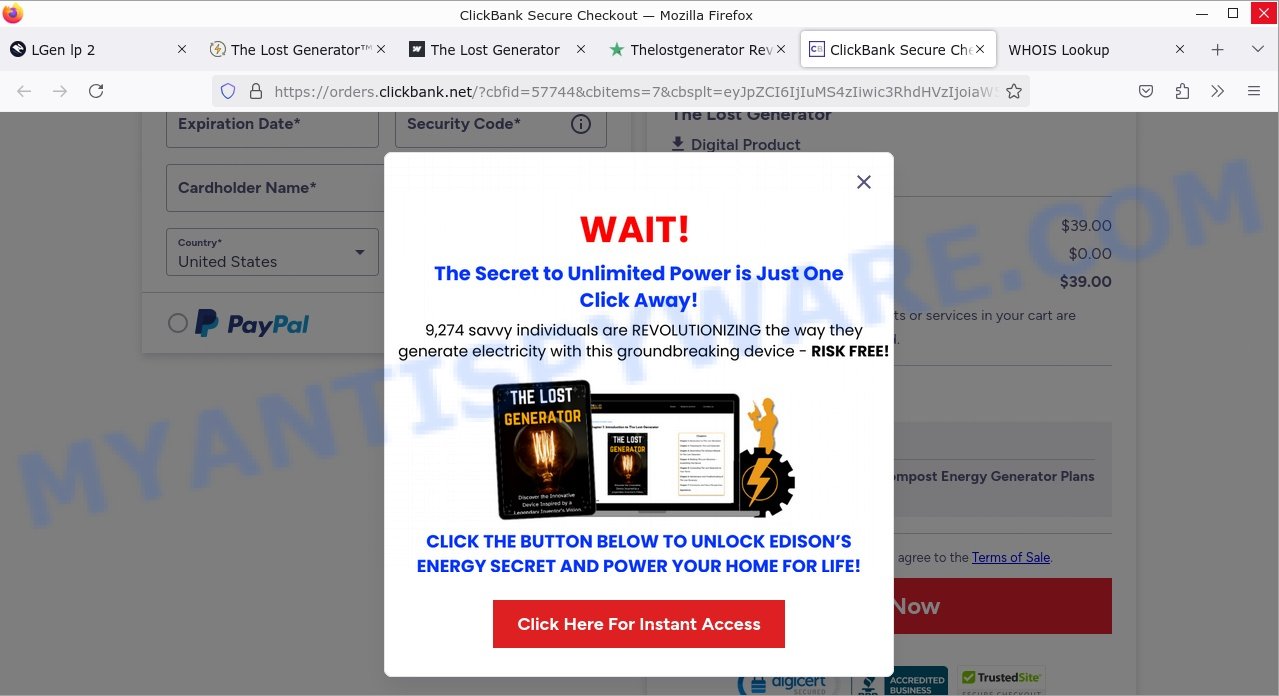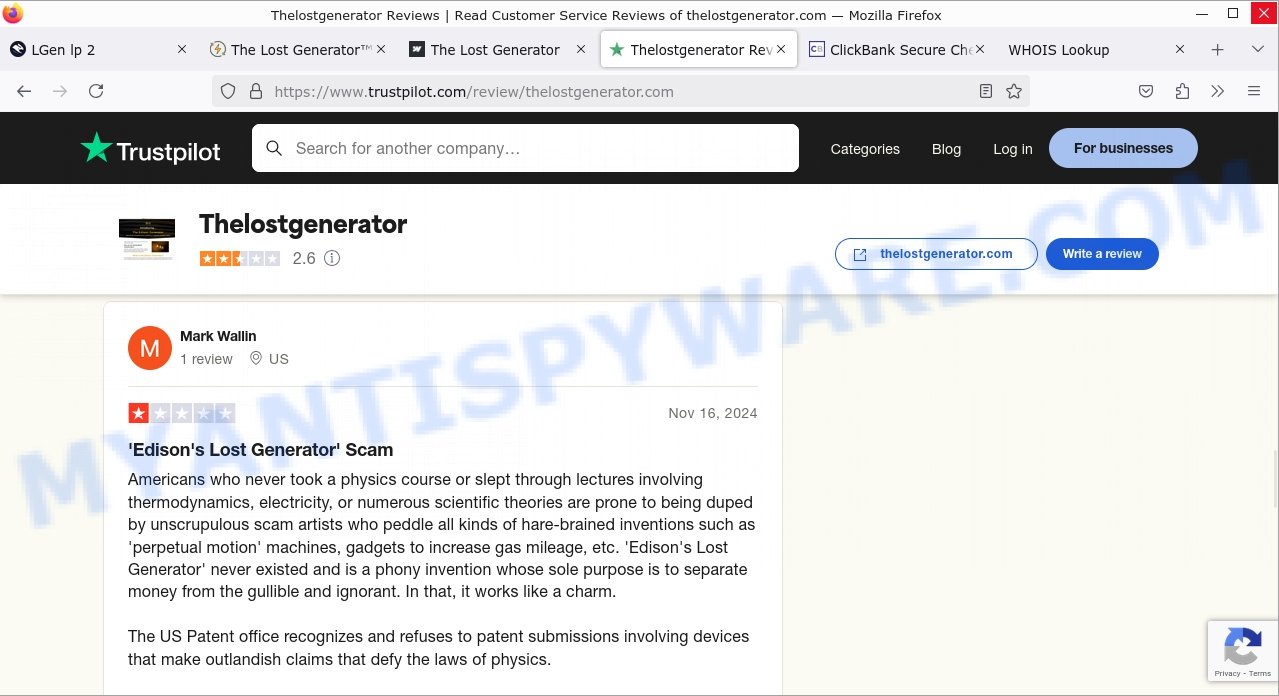The Lost Generator is a deceptive scheme that falsely claims to offer a revolutionary DIY energy device said to be rediscovered from Thomas Edison’s lost inventions. This scam is promoted through online ads and websites like thelostgenerator.com and expansive-life.com, luring people with promises of drastically reduced energy bills and energy independence from power companies.
However, the device is not real. Many users report that upon purchase, they only receive vague online articles without actual, practical instructions to build the so-called generator. The information provided is usually incomplete and unhelpful, leading buyers to realize that they’ve been duped. Reviews on platforms like TrustPilot often reflect disappointment, labeling this offer as a scam that relies on too-good-to-be-true claims to trick people into spending their money.
Feedback from individuals shows that there are difficulties in contacting the seller for refunds, despite promises of a money-back guarantee. This scam targets individuals looking to save on energy costs, taking advantage of their frustrations with current energy prices.

Table of Contents
 Scam Overview
Scam Overview
The Lost Generator scam, featuring the so-called “Edison’s Lost Invention”, is a fraudulent scheme advertised across platforms like Facebook. This scam asserts that individuals can gain energy independence and drastically reduce their energy bills by using a simple DIY generator that harnesses a lost invention by Thomas Edison, promising unrealistic cost savings and energy efficiency.

The scam ads include messages like:
“Imagine this: your neighbors are scrambling for flashlights while your home stays safe, warm, and fully powered.
This simple DIY invention doesn’t rely on expensive solar, wind, batteries, or the grid. It’s breakthrough technology by Thomas Edison, lost for generations, that’s finally been rediscovered.
And it’s already helping over 88,000 Americans take control of their energy, slashing bills while staying protected from blackouts and disasters.
Big energy corporations hate this device. Their executives rely on your monthly payments to fund their bonuses, and they’re doing everything they can to stop this presentation.
But right now, you still have a chance to learn how it works—and start saving thousands.”
Click the link below to watch a free presentation and find out how this simple, radical device can give you complete energy independence, making you your family’s hero.
Don’t wait—this page could be gone tomorrow.”
95% of People Don’t Know How to Slash Electricity Bills and Protect Their Family From Disasters
 Signs of the Scam
Signs of the Scam
- Fabricated Historical Claims: The scam alleges rediscovery of a lost Edison invention, which is historically inaccurate and unverifiable.
- Promises of Unrealistic Benefits: Ads claim that users can drastically reduce their energy bills and achieve energy independence with minimal effort and investment, which is highly dubious.
- Links to Suspicious Websites: Advertisements lead users to websites like expansive-life.com and thelostgenerator.com, which lack transparency and have questionable ownership details.
- Upfront Payment Demands: The site charges a fee for plans and blueprints without any proven results or credible testimonials.
- Emotional Marketing Tactics: The scam exploits emotional narratives involving survival situations to sell the dubious product.
- Pressure Sales Techniques: The marketing strategy includes urgency, suggesting that the offer may disappear soon, which pressures users into making a quick decision without proper verification.
In summary, the Lost Generator scam is an elaborate fraud that uses sensational claims, unclear instructions, and misleading stories to trick people into paying for a “lost invention” that promises free or dirt-cheap energy. The product’s promises conflict with basic scientific facts, and the negative reviews and hidden website details only add to the warning signs. Always approach such offers with caution, and verify any claims with trusted sources before spending your money.
 How The Lost Generator Scam Works
How The Lost Generator Scam Works
The Lost Generator scam is a deceptive scheme that has been widely promoted on social media platforms. This scam centers around misleading advertisements that claim an “Edison’s lost invention” can drastically cut your energy bills and provide you with unlimited energy. These ads lure people into visiting fraudulent websites where they are tricked into paying a fee for access to supposedly revolutionary energy-generating blueprints.
 Social Media Ads
Social Media Ads
Scammers run ads on platforms like Facebook and Instagram, using enticing headlines such as “Slash your energy bills” or “Discover Edison’s lost invention”. These ads often include false success stories, suggesting that ordinary people have dramatically reduced their energy expenses and gained energy independence with little effort. Many viewers, believing the ads are genuine, click through to learn more.

 Misleading Landing Pages
Misleading Landing Pages
The social media ads redirect users to scam websites like thelostgenerator.com. These sites feature long video presentations narrated by individuals claiming to be ordinary Americans who have benefited immensely from the invention. The videos are filled with exaggerated claims and false historical references to Thomas Edison to add credibility. However, inconsistencies—such as claims that do not align with basic scientific principles—raise serious doubts about the authenticity of the information.

 Fabricated Success Stories
Fabricated Success Stories
On these fraudulent websites, you will find testimonials and success stories about individuals who allegedly achieved complete energy independence shortly after building the device. These accounts are completely fabricated and are used to build trust, making the scam appear more legitimate than it is.

 Redirect to the Payment Page
Redirect to the Payment Page
After watching the video, viewers are prompted to click a link that leads to a payment page. Here, The Lost Generator plans are presented as a must-have digital solution for anyone looking to save money on energy. The site emphasizes the simplicity of the process, urging users to act fast before the “big energy corporations” shut it down.
 Attempting to Purchase the Program
Attempting to Purchase the Program
Enticed by the promises, victims proceed to purchase The Lost Generator plans for a fee. They are directed to a secure payment page that processes transactions through platforms like ClickBank. Despite the professional appearance of the payment system, buyers receive vague instructions and blueprints that provide no real method or system capable of delivering the promised results.

 Hidden Fees and Misleading Claims
Hidden Fees and Misleading Claims
Many victims later find that the content provided is generic and does not include any unique strategies or technologies. The promised energy independence is nowhere to be found, and users end up with a product that offers nothing more than basic information easily available elsewhere for free.
 ClickBank’s Role
ClickBank’s Role
While ClickBank is a legitimate platform, scammers often use it to lend a false sense of security to their schemes. The involvement of ClickBank does not validate the claims made by The Lost Generator; it is merely a tool used by the scammers to process payments.
 WHOIS Information
WHOIS Information
A look at the WHOIS information for thelostgenerator.com reveals that the domain was registered privately, with the registrant’s details hidden. This is a common tactic among scam operators to avoid being traced.
To Stay Safe, always be skeptical of offers that promise significant cost savings or energy independence with little effort. Verify any energy-saving claims through reliable sources and avoid providing personal or financial information to questionable websites.
 Beware of Similar Scams
Beware of Similar Scams
Scams like The Lost Generator, claiming to offer unlimited energy using a “lost invention” by Thomas Edison, are common traps for those searching for energy independence and lower bills. This scam follows a pattern seen in other fraudulent schemes that target individuals hoping for quick, effective solutions to complex problems. The Lost Generator scam promises drastic reductions in electricity costs and complete grid independence by using vague, secretive methods supposedly suppressed by big energy corporations. However, customers report that the product fails to deliver, featuring unclear instructions and lacking any scientific basis. Like other scams, such as Cash Phone – The 7 Minute Phone Trick, Wifi Profits App and Mini Mobile ATM, it uses high-pressure sales tactics, emotional storytelling, and unrealistic claims to lure in buyers.
 What to Do If Scammed
What to Do If Scammed
If you’ve been caught up in the Lost Generator scam, don’t panic. It’s important to act quickly to protect yourself and your finances. Here’s a step-by-step guide on what to do next:
 Contact Your Financial Institution
Contact Your Financial Institution
Immediately inform your bank or credit card company about the unauthorized transaction. They may be able to stop the transaction, reverse it, or even issue a chargeback. Request a new credit/debit card if you believe your card details have been compromised. Document any financial losses. This can be essential for investigations and potential reimbursements.
 Change Passwords
Change Passwords
If you suspect your personal information, especially passwords, have been compromised, change them immediately. This is crucial for accounts linked to financial institutions or personal data. Consider using a reputable password manager to ensure strong, unique passwords for each account.
 Monitor Your Accounts
Monitor Your Accounts
Keep a close eye on your bank and credit card statements for the next several months. Look for any unauthorized or suspicious transactions, no matter how small. Consider enrolling in a credit monitoring service. Some services will alert you to changes in your credit report, potentially indicating identity theft.
 Report the Scam
Report the Scam
If you encountered scam ads on Facebook, Instagram, TikTok or other platforms, report them so they can be removed.
 Check Your Computer
Check Your Computer
If you’ve downloaded any file or clicked on any links, your device might be infected. Run a comprehensive antivirus scan.
 Educate Yourself
Educate Yourself
Familiarize yourself with common scam tactics to avoid falling victim in the future. Stay updated on recent scams or phishing methods by following news sources or official government warnings.
 Inform Others
Inform Others
Warn friends and family about the scam, especially if it’s widespread. Sharing your experience can help protect others from the same pitfalls.
Summary Table
| Name | The Lost Generator, “Edison’s Lost Invention” |
| Type | Energy Generator Scam |
| Fake Claims | Promises unlimited energy and a 90% reduction in electricity bills using a supposed rediscovered invention by Thomas Edison. |
| Disguise | The scam uses compelling narratives, emotional appeals, and a professionally designed website that mimics legitimate energy-saving solutions. |
| Scammers’ Websites | Operates through websites like thelostgenerator.com, offering high promises with little technical detail or credible backing. |
| Credit Card Charge | Requires an initial payment of $39 for access to the supposed blueprints and designs. |
| Damage | Customers pay for access to information that is vague, potentially misleading, and lacks practical application, resulting in financial loss and dissatisfaction. |
| Distribution | Marketed through online ads and social media, enticing consumers with the promise of energy independence and savings. |
| Indicators of the Scam | Over-the-top claims not supported by science, emotional storytelling to sell products, negative reviews online, and difficulty obtaining refunds. |
| Prevention Tips | Scrutinize claims that seem too good to be true, seek out reputable energy solutions, and use secure payment methods to avoid fraud. |
| Reporting Info | Report scams to platforms where the ads appear and contact local consumer protection agencies. In the U.S., report to the Federal Trade Commission at reportfraud.ftc.gov. |
Conclusion
The Lost Generator scam is an online scheme that preys on individuals looking for energy independence and reduced utility bills. Promoted mainly through ads on platforms like Facebook, this scam offers a miraculous device, supposedly based on a rediscovered invention by Thomas Edison, that claims to drastically slash energy costs and provide off-grid power. For a fee, consumers receive blueprints and instructions that are vague and lack practical application, failing to deliver the promised results.
The websites promoting The Lost Generator use compelling narratives and emotional appeals to urgency, suggesting that big energy corporations are trying to shut them down. However, these sites have hidden ownership details, and the product reviews from actual buyers are overwhelmingly negative, highlighting ineffective results and poor customer support.
This scam serves as a reminder to approach online offers that sound too good to be true with skepticism. It’s crucial to research thoroughly, check independent reviews, and consider realistic outcomes before making any payments. Protect yourself by staying informed and cautious about offers that promise revolutionary results with little effort or investment. Always remember, if it sounds too good to be true, it likely is. Stay safe and question where your money is going.



















